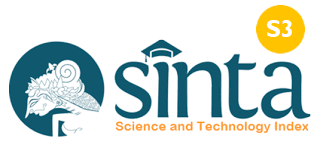Menerjemahkan Perubahan Dari TCL (Teacher Center Learning) Ke SCL (Student Center Learning)
Abstract
The problematic education in Indonesia still uses the old paradigm, which is dominated by the role and activities of teachers. In answer the problematic of the National Education System Law No. 20 of 2003 indicates a change from teaching to learning. The rationale above becomes imperative of teachers should have insight into the characteristics of student-centered learning so that it can be applied in learning. Student-centered learning encourages students to be actively involved in building knowledge, attitudes and behaviors. In the student-centered learning process, students have the opportunity and facilities to build their own knowledge so that they will gain a deep understanding and ultimately improve the quality of the students.
Innovative learning with student-centered methods has a diversity of learning models / methods that demand the active participation of students. There are several SCL (1) Small Group Discussion (SGD) learning models (2) Role-Play and Simulation. (8) Collaborative Learning (CbL) (9) Project Based Learning (PBL) ). It is expected that educators will make this learning model (Student Centered Learning) as an alternative in the learning process.
References
Ary Ginanjar Agustian (2002). Emotional Spritual Quotient (ESQ). Jakarta: Arga.
Buku Kerja, (2000), Ancangan Aplikasi Peningkatan Proses Belajar Mengajar, APTIK
Burton, L (1993). The Constructivist Classroom Education in Profile. Perth: Edith Cowan University.
Buzan, Tony (1989). Use Both Sides of Yoru Brain, 3rd ed. New York: Penguin Books.
Cord (2001). What is Contextual Learning. WWI Publishing Texas: Waco.
Cook J, Cook L. How technology enhances the quality of student -centered learning. Quality Progress 1998;31(7):59-63.
De Porter, Bobbi (1992). Quantum Learning. New York: Dell Publishing.
Ditdik SLTP (2002). Pendekatan Kontekstual (Contextual Teaching and Learning, CTL). Jakarta.:Depdiknas.
Erman, S.Ar., dkk. (2002). Strategi Pembelajaran Matematika Kontemporer. Bandung: JICA-FPMIPA.
Fischer G , Palen L. Learner-centered design: beyond “gift -wrapping”. Center forLifelong Learning & DesignUniversity of Colorado at Boulder 1999.
Gardner, Howard (1985). Frame of Mind: The Theory of Multiple Ilntelligences. New York: Basic Bools.
Goleman, Daniel (1995). Emotional Intelligence. New York: Bantam Books.
Harsono, (2004), Kearifan dalam transformasi pembelajaran: dari teacher-centered ke student-centered learning, Makalah Seminar Implementasi nilai kearifan dalam proses pembelajaran berorientasi student-centered learning UGM.
Materi Pelatihan Kurikulum Berbasis Kompetensi, (2008), Model Pembelajaran, DIKTI.
Sudarsana, I. K. (2018). Pengaruh Model Pembelajaran Kooperatif Terhadap Peningkatan Mutu Hasil Belajar Siswa. Jurnal Penjaminan Mutu, 4(1), 20-31.
Sudarsana, I. K. (2018). MEMBENTUK KARAKTER ANAK SEBAGAI GENERASI PENERUS BANGSA MELALUI PENDIDIKAN ANAK USIA DINI. Jurnal Purwadita, 1(1).
Siswomihardjo KW. Kearifan Guru Besar dalam perspektif normatif dan aktualitasnya. Focus Group Discussion: Kearifan Guru besar, Keteladanan / Budaya Panutan; Universitas Gadjah M ada, 29 Oktober 2004.
Downloads
Published
How to Cite
Issue
Section
License
An author who publishes in the Cetta : Jurnal Ilmu Pendidikan agrees to the following terms:
- Author retains the copyright and grants the journal the right of first publication of the work simultaneously licensed under the Creative Commons Attribution-ShareAlike 4.0 License that allows others to share the work with an acknowledgement of the work's authorship and initial publication in this journal
- Author is able to enter into separate, additional contractual arrangements for the non-exclusive distribution of the journal's published version of the work (e.g., post it to an institutional repository or publish it in a book) with the acknowledgement of its initial publication in this journal.
- Author is permitted and encouraged to post his/her work online (e.g., in institutional repositories or on their website) prior to and during the submission process, as it can lead to productive exchanges, as well as earlier and greater citation of the published work (See The Effect of Open Access).
Read more about the Creative Commons Attribution-ShareAlike 4.0 Licence here: https://creativecommons.org/licenses/by-sa/4.0/.





